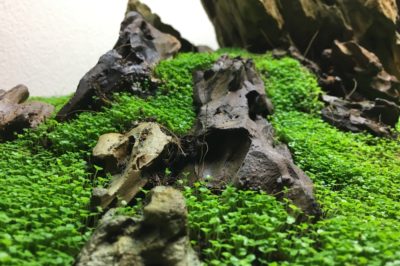About Dwarf Baby Tears
One of the smallest aquarium plants, dwarf baby tears is a bright green in color. It grows to a height of about one inch and a single plant will spread about three inches. The leaves are tiny – only about 3/10 of an inch long – and are closely spaced on the stem so that the plant will quickly develop the appearance of a thick, carpet-like mat.
Cultural Requirements
In the wild, dwarf baby tears appears in stream beds during the dry season. When growing in an aquarium, it needs the following conditions:
- Good water quality with water hardness of 4 to 5 dGH.
- A pH of 5.0 to 7.50.
- A temperature range of 68 to 82°F (20 to 29°C).
- Bright light for 10 to 14 hours a day.
Using Baby Tears in Aquarium
In addition to improving the appearance of an aquarium with what looks like a bright green mossy carpet, dwarf baby tears has other advantages. It will produce the bubbles known as perls to help oxygenate the water. Spawning fish will often use the plant to lay their eggs. Dwarf baby tears can help reduce algae growth and improve the water clarity in an aquarium.
Caring for Dwarf Baby Tears
Dwarf baby tears is slow to moderate growing under good conditions. Prepare the aquarium with a fine-grained substrate and place a layer of aqua soil powder on top to provide a good anchor for the roots. Change the water every other week to remove excess nutrients and waste products. This will also help control the growth of algae, which limits light.
Lighting for Dwarf Baby Tears
To mimic proper conditions indoors, you will need artificial lighting. A full-spectrum fluorescent bulb produces the right kind of light. You’ll want to add color-enhancing bulbs for the best esthetic effect. Bulbs are rated according to the Kelvin scale. Full sun at noon has a Kelvin rating of 5500°K; use this for comparison purposes when choosing bulbs.
The Right Lighting
The contents and inhabitants of your aquarium affect its light needs. Research the light needs of all aquarium inhabitants. The rule most commonly used is 2 to 5 watts per gallon for a freshwater aquarium such as those containing dwarf baby tears. To calculate, divide the fixture’s total wattage by the gallons in the aquarium. Use a timer to ensure 10 to 14 hours of light each day.
